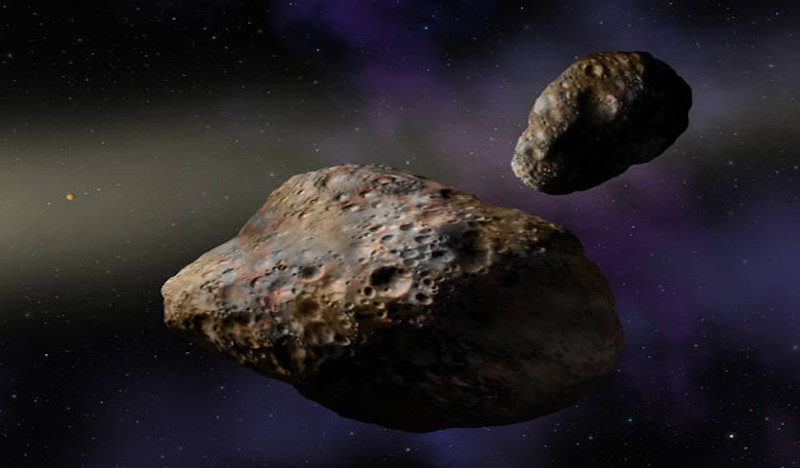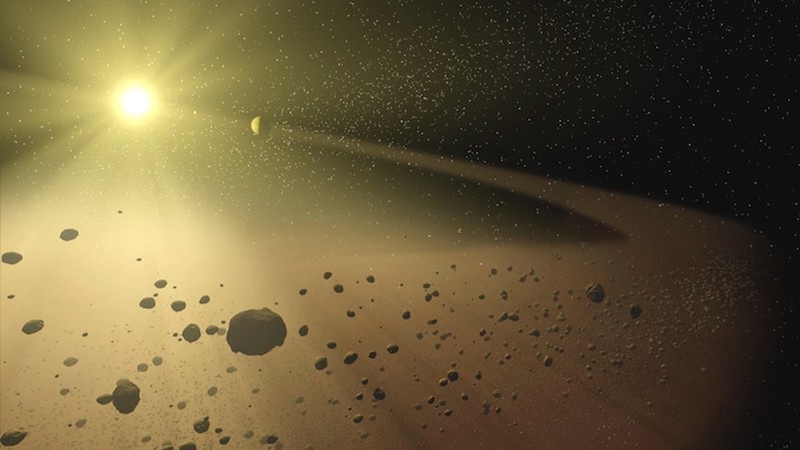
The 2 reddest asteroids
The main asteroid belt between Mars and Jupiter is estimated to contain over a million objects larger than a kilometer (0.6 miles) in diameter. Plus there are millions more smaller chunks of rocky debris in the belt, all whirling around the sun. And, for the most part, these millions of asteroids are pretty similar in composition and appearance. But now, with new observations, astronomers say they’ve found two asteroids in the belt that, frankly, shouldn’t be there. These rocky bodies are the two reddest asteroids ever seen in the asteroid belt.
The peer-reviewed Astrophysical Journal published this new work on July 26, 2021. The Japan Aerospace Exploration Agency (JAXA) announced the discovery in a press release on July 27. Veteran science writer George Dvorsky featured it in a article at Gizmodo on July 30.
Rich in organic material
The intriguing discovery was made by astronomer Sunao Hasegawa and his team at JAXA. Asteroids as red as these ones – 203 Pompeja and 269 Justitia – are not typically seen in the asteroid belt. This is because asteroids closer to the sun have little organic material on their surfaces, while asteroids farther out are coated in complex organics. These are thought to be produced from simpler organic compounds like methane and methanol ice.
Other low albedo asteroids in the belt, called D-type asteroids, have long been thought to be the reddest. But it seems that is no longer the case.

Trans-Neptunian objects?
For this reason, the researchers think these may be trans-Neptunian objects (TNOs), asteroids that inhabit the distant outer solar system beyond Neptune. Their surface composition is very similar to TNOs. According to the paper:
These two asteroids have a redder spectral slope than any other D-type body, which are the reddest objects in the asteroid belt. Spectroscopic results suggest the presence of complex organic materials on the surface layer of these asteroids, implying that they could have formed in the vicinity of Neptune.
But then how did they end up in the main asteroid belt?
The researchers say that these objects likely drifted inward while the solar system was still young. Exactly why that happened isn’t known, but it indicates that the early solar system was a very chaotic place.

The first of many?
Because these objects are so much redder than typical asteroids in the main belt, they stood out like a sore thumb. It seems likely there may well be more of them, too. It could be that many asteroids in the main belt actually originated from farther out in the solar system. If so, identifying them could provide valuable clues about how the early solar system formed.
The main asteroid belt, therefore, may be a mixed bag of asteroids that formed closer to the sun and ones that drifted in from elsewhere. The solar system can be a messy place.
Cataloging populations of large asteroids
The two unusually red asteroids were noticed as the result of a new study to catalog the composition and distribution of large asteroids in the main belt. The NASA Infrared Telescope Facility (IRTF) and Seoul National University Astronomical Observatory (SAO) were used in this effort. Scientists from MIT, the University of Hawai‘i, Seoul National University, Kyoto University and other institutions colloborated in the study.

203 Pompeja and 269 Justitia are both larger asteroids, so they were included in the observations. 203 Pompeja is 68 miles (110 km) in diameter, and 269 Justitia is about half as large.
The surprising discovery of these red asteroids, and perhaps others in the future, will provide valuable clues about the formation of the early solar system. It was a chaotic place back then, maybe even more than first thought.
The future
There’s another bonus, too. If some TNOs found their way to the asteroid belt, then it would be easier to study them with future probes. NASA’s New Horizons probe is currently exploring the distant Kuiper Belt beyond Neptune. But studying some TNOs up close may now be as easy as going to the asteroid belt, which is a lot closer. A probe could study both typical asteroid belt bodies as well as TNOs.
Bottom line: Astronomers have discovered two asteroids in the asteroid belt between Mars and Jupiter that are much redder than any of their neighbors. The researchers say they likely migrated inward from the outer reaches of the solar system.
Source: Discovery of Two TNO-like Bodies in the Asteroid Belt











